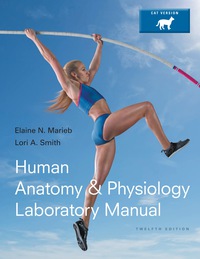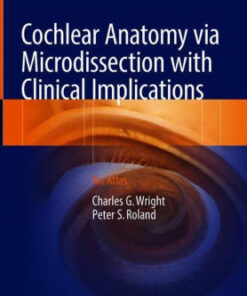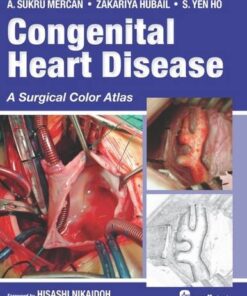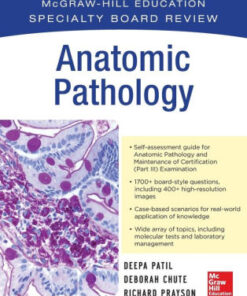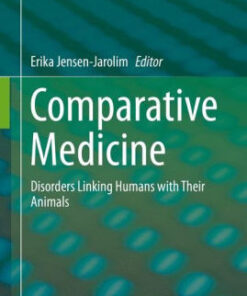(PDF) Human Anatomy & Physiology Cat Version 12th Edition by Marieb
$22.00
Download instantly Human Anatomy & Physiology Laboratory Manual, Cat Version 12th Edition by Elaine N. Marieb, Lori A. Smith. It is ebook in PDF format.
ISBN-10: 0321971353 ISBN-13: 9780321971357
Preview
This is the PDF eBook version for Human Anatomy & Physiology Laboratory Manual, Cat Version 12th Edition by Elaine N. Marieb, Lori A. Smith
Table of Contents
Acknowledgments
1. The Language of Anatomy
1. Locating Body Regions
2. Practicing Using Correct Anatomical Terminology
3. Observing Sectioned Specimens
4. Identifying Organs in the Abdominopelvic Cavity
5. Locating Abdominal Surface Regions
Group Challenge: The Language of Anatomy
Review Sheet
2. Organ Systems Overview
1. Observing External Structures
2. Examining the Oral Cavity
3. Opening the Ventral Body Cavity
4. Examining the Ventral Body Cavity
5. Examining the Human Torso Model
Group Challenge: Odd Organ Out
Review Sheet
3. The Microscope
1. Identifying the Parts of a Microscope
2. Viewing Objects Through the Microscope
3. Estimating the Diameter of the Microscope Field
4. Perceiving Depth
5. Preparing and Observing a Wet Mount
Review Sheet
4. The Cell: Anatomy and Division
1. Identifying Parts of a Cell
2. Identifying Components of a Plasma Membrane
3. Locating Organelles
4. Examining the Cell Model
5.Observing Various Cell Structures
6. Identifying the Mitotic Stages
7. “Chenille Stick” Mitosis
Review Sheet
5. The Cell: Transport Mechanisms and Cell Permeability
1. Observing Diffusion of Dye Through Agar Gel
2. Observing Diffusion of Dye Through Water
3. Investigating Diffusion and Osmosis Through Nonliving Membranes
4. Observing Osmometer Results
5. Investigating Diffusion and Osmosis Through Living Membranes
6. Observing the Process of Filtration
7. Observing Phagocytosis
Group Challenge: Comparing and Contrasting Membrane Transport Processes
Review Sheet
6. Classification of Tissues
1. Examining Epithelial Tissue Under the Microscope
Group Challenge 1: Identifying Epithelial Tissues
2. Examining Connective Tissue Under the Microscope
3. Examining Nervous Tissue Under the Microscope
4. Examining Muscle Tissue Under the Microscope
Group Challenge 2: Identifying Connective Tissue
Review Sheet
7. The Integumentary System
1. Locating Structures on a Skin Model
2. Identifying Nail Structures
3. Comparing Hairy and Relatively Hair-Free Skin Microscopically
4. Differentiating Sebaceous and Sweat Glands Microscopically
5. Plotting the Distribution of Sweat Glands
6. Taking and Identifying Inked Fingerprints
Review Sheet
8. Overview of the Skeleton: Classification and Structure of Bones and Cartilages
1. Examining a Long Bone
2. Examining the Effects of Heat and Hydrochloric Acid on Bones
3. Examining the Microscopic Structure of Compact Bone
4. Examining the Osteogenic Epiphyseal Plate
Review Sheet
9. The Axial Skeleton
1. Identifying the Bones of the Skull
Group Challenge: Odd Bone Out
2. Palpating Skull Markings
3. Examining Spinal Curvatures
4. Examining Vertebral Structure
5. Examining the Relationship Between Ribs and Vertebrae
6. Examining a Fetal Skull
Review Sheet
10. The Appendicular Skeleton
1. Examining and Identifying Bones of the Appendicular Skeleton
2. Palpating the Surface Anatomy of the Pectoral Girdle and the Upper Limb
3. Observing Pelvic Articulations
4. Comparing Male and Female Pelves
5. Palpating the Surface Anatomy of the Pelvic Girdle and Lower Limb
6. Constructing a Skeleton
Review Sheet
11. Articulations and Body Movements
1. Identifying Fibrous Joints
2. Identifying Cartilaginous Joints
3. Examining Synovial Joint Structure
4. Demonstrating the Importance of Friction-Reducing Structures
5. Demonstrating Movements of Synovial Joints
6. Demonstrating Actions at the Hip Joint
7. Demonstrating Actions at the Knee Joint
8. Demonstrating Actions at the Shoulder Joint
9. Examining the Action at the TMJ
Group Challenge: Articulations: “Simon Says”
Review Sheet
12. Microscopic Anatomy and Organization of Skeletal Muscle
1. Examining Skeletal Muscle Cell Anatomy
2. Observing the Histological Structure of a Skeletal Muscle
3. Studying the Structure of a Neuromuscular Junction
Review Sheet
13. Gross Anatomy of the Muscular System
1. Identifying Head and Neck Muscles
2. Identifying Muscles of the Trunk
3. Identifying Muscles of the Upper Limb
4. Identifying Muscles of the Lower Limb
Group Challenge: Name That Muscle
5. Review of Human Musculature
6. Making a Muscle Painting
Review Sheet
14. Skeletal Muscle Physiology: Frogs and Human Subjects
1. Observing Muscle Fiber Contraction
2. Inducing Contraction in the Frog Gastrocnemius Muscle
3. Demonstrating Muscle Fatigue in Humans
4. Electromyography in a Human Subject Using BIOPAC®
Review Sheet
15. Histology of Nervous Tissue
1. Identifying Parts of a Neuron
2. Studying the Microscopic Structure of Selected Neurons
3. Examining the Microscopic Structure of a Nerve
Review Sheet
16. Neurophysiology of Nerve Impulses: Frog Subjects
1. Stimulating the Nerve
2. Inhibiting the Nerve
3. Visualizing the Compound Action Potential with an Oscilloscope
Review Sheet
17. Gross Anatomy of the Brain and Cranial Nerves
1. Identifying External Brain Structures
2. Identifying Internal Brain Structures
3. Identifying and Testing the Cranial Nerves
Group Challenge: Odd (Cranial) Nerve Out
Review Sheet
18. Electroencephalography
1. Observing Brain Wave Patterns Using an Oscilloscope or Physiograph
2. Electroencephalography Using BIOPAC®
Review Sheet
19. The Spinal Cord and Spinal Nerves
1. Identifying Structures of the Spinal Cord
2. Identifying Spinal Cord Tracts
3. Identifying the Major Nerve Plexuses and Peripheral Nerves
Group Challenge: Fix the Sequence
Review Sheet
20. The Autonomic Nervous System
1. Locating the Sympathetic Trunk
2. Comparing Sympathetic and Parasympathetic Effects
3. Exploring the Galvanic Skin Response (Electrodermal Activity) Within a Polygraph Using BIOPAC®
Review Sheet
21. Human Reflex Physiology
1.Initiating Stretch Reflexes
2. Initiating the Crossed-Extensor Reflex
3.Initiating the Plantar Reflex
4. Initiating the Corneal Reflex
5. Initiating the Gag Reflex
6. Initiating Pupillary Reflexes
7. Initiating the Ciliospinal Reflex
8. Initiating the Salivary Reflex
9.Testing Reaction Time for Intrinsic and Learned Reflexes
10. Measuring Reaction Time Using BIOPAC®
Review Sheet
22. General Sensation
1. Studying the Structure of Selected Sensory Receptors
2. Determining the Two-Point Threshold
3. Testing Tactile Localization
4. Demonstrating Adaptation of Touch Receptors
5. Demonstrating Adaptation of Temperature Receptors
6. Demonstrating the Phenomenon of Referred Pain
Review Sheet
23. Special Senses: Anatomy of the Visual System
1. Identifying Accessory Eye Structures
2. Identifying Internal Structures of the Eye
3. Studying the Microscopic Anatomy of the Retina
4. Predicting the Effects of Visual Pathway Lesions
Review Sheet
24. Special Senses: Visual Tests and Experiments
1. Demonstrating the Blind Spot
2. Determining Near Point of Accommodation
3. Testing Visual Acuity
4. Testing for Astigmatism
5. Testing for Color Blindness
6. Testing for Depth Perception
7. Demonstrating Reflex Activity of Intrinsic and Extrinsic Eye Muscles
8. Conducting an Ophthalmoscopic Examination
Review Sheet
25. Special Senses: Hearing and Equilibrium
1. Identifying Structures of the Ear
2. Examining the Ear with an Otoscope (Optional)
3. Examining the Microscopic Structure of the Cochlea
4. Conducting Laboratory Tests of Hearing
5. Audiometry Testing
6. Examining the Microscopic Structure of the Crista Ampullaris
7. Conducting Laboratory Tests on Equilibrium
Review Sheet
26. Special Senses: Olfaction and Taste
1. Microscopic Examination of the Olfactory Epithelium
2. Microscopic Examination of Taste Buds
3. Stimulating Taste Buds
4. Examining the Combined Effects of Smell, Texture, and Temperature on Taste
5. Assessing the Importance of Taste and Olfaction in Odor Identification
6. Demonstrating Olfactory Adaptation
Review Sheet
27. Functional Anatomy of the Endocrine Glands
1. Identifying the Endocrine Organs
2. Examining the Microscopic Structure of Endocrine Glands
Group Challenge: Odd Hormone Out
Review Sheet
28. Endocrine Wet Labs and Human Metabolism
1. Determining the Effect of Pituitary Hormones on the Ovary
2. Observing the Effects of Hyperinsulinism
Group Challenge: Thyroid Hormone Case Studies
Review Sheet
29. Blood
1. Determining the Physical Characteristics of Plasma
2. Examining the Formed Elements of Blood Microscopically
3. Conducting a Differential WBC Count
4. Determining the Hematocrit
5. Determining Hemoglobin Concentration
6. Determining Coagulation Time
7. Typing for ABO and Rh Blood Groups
8. Observing Demonstration Slides
9. Measuring Plasma Cholesterol Concentration
Review Sheet
30. Anatomy of the Heart
1. Using the Heart Model to Study Heart Anatomy
2. Tracing the Path of Blood Through the Heart
3. Using the Heart Model to Study Cardiac Circulation
4. Examining Cardiac Muscle Tissue Anatomy
Review Sheet
31. Conduction System of the Heart and Electrocardiography
1A. Recording ECGs Using a Standard ECG Apparatus
1B. Electrocardiography Using BIOPAC®
Review Sheet
32. Anatomy of Blood Vessels
1. Examining the Microscopic Structure of Arteries and Veins
2. Locating Arteries on an Anatomical Chart or Model
3. Identifying the Systemic Veins
4. Identifying Vessels of the Pulmonary Circulation
Group Challenge: Fix the Blood Trace
5. Tracing the Pathway of Fetal Blood Flow
6. Tracing the Hepatic Portal Circulation
Review Sheet
33. Human Cardiovascular Physiology: Blood Pressure and Pulse Determinations
1. Auscultating Heart Sounds
2. Palpating Superficial Pulse Points
3. Measuring Pulse Using BIOPAC®
4. Taking an Apical Pulse
5. Using a Sphygmomanometer to Measure Arterial Blood Pressure Indirectly
6. Estimating Venous Pressure
7. Observing the Effect of Various Factors on Blood Pressure and Heart Rate
8. Examining the Effect of Local Chemical and Physical Factors on Skin Color
Review Sheet
34. Frog Cardiovascular Physiology
1. Investigating the Automaticity and Rhythmicity of Heart Muscle
2. Recording Baseline Frog Heart Activity
3. Investigating the Refractory Period of Cardiac Muscle Using the Physiograph
4. Assessing Physical and Chemical Modifiers of Heart Rate
5. Investigating the Effect of Various Factors on the Microcirculation
Review Sheet
35. The Lymphatic System and Immune Response
1. Identifying the Organs of the Lymphatic System
2. Studying the Microscopic Anatomy of a Lymph Node, the Spleen, and a Tonsil
Group Challenge: Compare and Contrast Lymphoid Organs and Tissues
3. Using the Ouchterlony Technique to Identify Antigens
Review Sheet
36. Anatomy of the Respiratory System
1. Identifying Respiratory System Organs
2. Demonstrating Lung Inflation in a Sheep Pluck
3. Examining Prepared Slides of Trachea and Lung Tissue
Review Sheet
37. Respiratory System Physiology
1. Operating the Model Lung
2. Auscultating Respiratory Sounds
3. Measuring Respiratory Volumes Using Spirometers
4. Measuring the FVC and FEV1
5. Measuring Respiratory Volumes Using BIOPAC®
6. Visualizing Respiratory Variations
7. Demonstrating the Reaction Between Carbon Dioxide (in Exhaled Air) and Water
8. Observing the Operation of Standard Buffers
9. Exploring the Operation of the Carbonic Acid–Bicarbonate Buffer System
Review Sheet
38. Anatomy of the Digestive System
1. Identifying Alimentary Canal Organs
2. Studying the Histologic Structure of the Stomach and the Gastroesophageal Junction
3. Observing the Histologic Structure of the Small Intestine
4.Examining the Histologic Structure of the Large Intestine
5. Identifying Types of Teeth
6. Studying Microscopic Tooth Anatomy
7. Examining Salivary Gland Tissue
8. Examining the Histology of the Liver
Review Sheet
39. Digestive System Processes: Chemical and Physical
1. Assessing Starch Digestion by Salivary Amylase
2. Assessing Protein Digestion by Trypsin
3. Demonstrating the Emulsification Action of Bile and Assessing Fat Digestion by Lipase
4. Reporting Results and Conclusions
Group Challenge: Odd Enzyme Out
5. Observing Movements and Sounds of the Digestive System
6. Viewing Segmental and Peristaltic Movements
Review Sheet
40. Anatomy of the Urinary System
1. Identifying Urinary System Organs
2. Studying Nephron Structure
3. Studying Bladder Structure
Group Challenge: Urinary System Sequencing
Review Sheet
41. Urinalysis
1. Analyzing Urine Samples
2. Analyzing Urine Sediment Microscopically (Optional)
Review Sheet
42. Anatomy of the Reproductive System
1. Identifying Male Reproductive Organs
2. Penis
3. Seminal Gland
4. Epididymis
5. Identifying Female Reproductive Organs
6. Wall of the Uterus
7. Uterine Tube
Review Sheet
43. Physiology of Reproduction: Gametogenesis and the Female Cycles
1. Identifying Meiotic Phases and Structures
2. Examining Events of Spermatogenesis
3. Examining Meiotic Events Microscopically
4. Examining Oogenesis in the Ovary
5. Comparing and Contrasting Oogenesis and Spermatogenesis
6. Observing Histological Changes in the Endometrium During the Menstrual Cycle
Review Sheet
44. Survey of Embryonic Development
1. Microscopic Study of Sea Urchin Development
2. Examining the Stages of Human Development
3. Identifying Fetal Structures
4. Studying Placental Structure
Review Sheet
45. Principles of Heredity
1. Working Out Crosses Involving Dominant and Recessive Genes
2. Working Out Crosses Involving Incomplete Dominance
3. Working Out Crosses Involving Sex-Linked Inheritance
4. Exploring Probability
5. Using Phenotype to Determine Genotype
6. Using Agarose Gel Electrophoresis to Identify Normal Hemoglobin, Sickle Cell Anemia, and Sickle C
Group Challenge: Odd Phenotype Out
Review Sheet
46. Surface Anatomy Roundup
1. Palpating Landmarks of the Head
2. Palpating Landmarks of the Neck
3. Palpating Landmarks of the Trunk
4. Palpating Landmarks of the Abdomen
5. Palpating Landmarks of the Upper Limb
6. Palpating Landmarks of the Lower Limb
Review Sheet
Cat Dissection Exercises
1. Dissection and Identification of Cat Muscles
2. Dissection of Cat Spinal Nerves
3. Identification of Selected Endocrine Organs of the Cat
4. Dissection of the Blood Vessels of the Cat
5. The Main Lymphatic Ducts of the Cat
6. Dissection of the Respiratory System of the Cat
7. Dissection of the Digestive System of the Cat
8. Dissection of the Urinary System of the Cat
9. Dissection of the Reproductive System of the Cat
PhysioEx 9.1 Computer Simulations Exercises
1. Cell Transport Mechanisms and Permeability
2. Skeletal Muscle Physiology
3. Neurophysiology of Nerve Impulses
4. Endocrine System Physiology
5. Cardiovascular Dynamics
6. Cardiovascular Physiology
7. Respiratory System Mechanics
8. Chemical and Physical Processes of Digestion
9. Renal System Physiology
10. Acid-Base Balance
11. Blood Analysis
12. Serological Testing
Credits
Index
Laboratory Safety Guidelines
The Metric System
Back Cover
